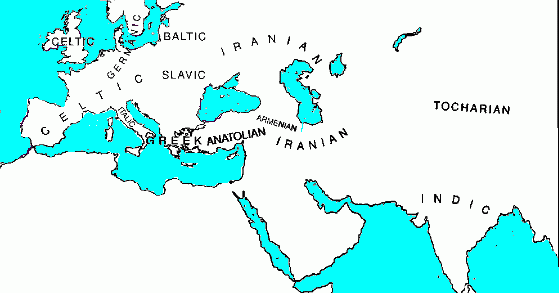Indo-European Language and Culture: An Introduction
Benjamin W. Fortson
Fortson, Benjamin W.;
Indo-European Language and Culture: An Introduction
Wiley-Blackwell, 2004, 488 pages
ISBN 1405103167 9781405103169
topics: | linguistic | language-family | indo-european | phonetics

Indo-european peoples (~ 500 BC) Focuses on pronunciation change and other aspects of reconstructing languages and families. covers a lot of the theory on "laryngeal" changes and other diachronic processes. phonology, morphology, and syntax of reconstructed Proto-Indo-European. The focus of analysis can be seeen in the sequence of chapters: Proto-IE: chapters 2 to 4 Proto-IE Verb, Noun, Pronoun, Syntax: ch 5 to 8 Anatolian: 9 [PIE vocab I: man, woman, kinship] p. 154-179 [26] Indo-Iranian I: Indic : 10 [PIE vocab II: animals] p. 180 [23] Indo-Iranian II: Iranian : 11 [PIE vocab III: food and agriculture] p.203 [19] Greek : 12 p.222 [PIE vocab: the body] Italic: 13 p.245 [PIE vocab: body functions / states] Celtic: 14 p.274 [PIE vocab: natural environment] Germanic: 15 300 [PIE vocab: position and motion ] Armenian: 16, 337 [PIE vocab: material culture, technology] Tocharian: 17, 351 [PIE vocab: Form and Size] Balto-Slavic, 18 364 [PIE vocab: Time] Albanian: 19 390 [PIE vocab: Utterance] Fragmentary Languages: 400 [PIE vocab: basic physical actsa] However, a cursory look at the map (based on map from p.11 of the book), reveals the large geographical area, traditionally closely populated from very ancient times, between the Indic and the Iranian. Indeed, this is the region that has given the world the first description of phonology; surely this area deserves a finer discrimination than what has transpired so far.
1 Introduction: The Comparative Method and the Indo-European Family
Reconstructing dead languages
Sources of evidence for reconstructing ancient languages: - contemporary descriptions - descendant languages [can apply comparative method] - orthographic practice (including spelling errors) - rendering of loanwords from known source languages - metrical evidence from poetry Sometimes, as in the case of Sanskrit, we are fortunate in having detailed descriptions of the language's pronunciation and structure by ancient grammarians. e.g. educated romans of the 1st c. BC rendered the greek letter phi (Φ) as ph in words such as philosophia. The sequence ph was not used in native words, so it must have represented a sound that was missing in their own language - an aspirated stop consonant, as it happens, different from the latin unaspirated p, and also from the Latin fricative f. 6
Philology
linguistic analysis of texts : philology - "the art of reading slowly", now called comparative historical linguistics. 7 Comparing copied versions of ancient texts, where the original source manuscript (archetypes) are lost, looking at errors and modernizations reveal systematicity in the change. Example 1. Gk prophetes, prophet. -phetes = 'sayer', and pro- can be 'before' or 'forth'. There is a verb prophemi 'I speak before', so one may conclude that prophetes is derived from this verb and means 'one who speaks beforehand'. However, looking at textual occurrences show that prophetes appears a good 700 years before prophemi. We conclude that 'prophet' was originally one who spoke forth or announced the will of the gods, rather than one who foretold the future. Example 2. Sanskrit naveda-, 'knowledgeable', is clearly related to veda-, 'knowledge', but the first element, na-, is not a known prefix anywhere else in the lg, and seems to have little effect on the overall sense. ... Frequently naveda- appears as part of the phrase 'be ye knowledegeable (of)'. A version of this is bhUta navedAH, 'be ye knowledegeable', where bhUta is the plural imperative 2nd p of the verb 'to be'. A common variant of bhUta is bhUtana with the optional element -na. We can thus reasonably surmise that someone in the course of transmission misanalyzed this particle as prefix. As in the English an ekename, 'a supplementary name', was reanalyzed as a nekename --> nickname. p.7-8
Controversy and change in IE linguistics
The discovery of Anatolian and Tocharian in the 20th c. has fueled debate on the internal structure of the PIE family tree. Anatolian, the oldest attested branch, is significantly different from the picture of PIE that scholars had developed at the end of the 19th c. [the picture of PIE has been in constant change over more than two centuries of study, hence] The account of linguistic history given in this book is not an immutable truth.
Links
Thomas V. Gamkrelidze and V. V. Ivanov Early History of Indo-European Languages Scientific American 1990Gamkrelidze and Ivanov argue that the European branches of PIE emigrated from a version spoken east of the Caspian. [AM: Given that all the early evidence is well east of the caucasus, it is not clear why the posited homeland should be so far to the west. ]
amitabha mukerjee (mukerjee [at-symbol] gmail) 2011 Jul 31